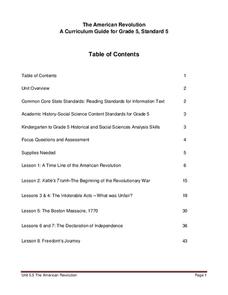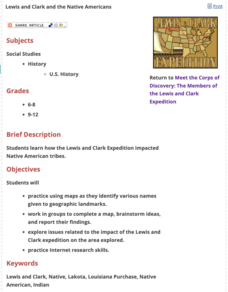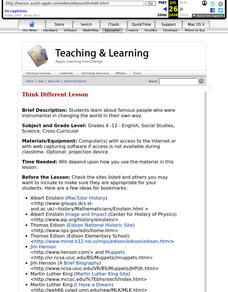Curated OER
Malcolm X and Race Relations
Learners read sections of Malcolm X's autobiography. In groups, they create a poster which highlights the events in his life and explains his philosophy on race relations. They present their poster to the class and answer any questions...
Curated OER
World War II Alien Enemy Control Program
Students review the history and language of the Alien Enemies Act and related laws as well as the Constitutional challenges it presents. They also review the World War II Alien Enemy Control Program and the Alien Enemy Hearing Board...
Curated OER
Historical Figures
Student research a "Historical Individual" using the Internet. They print a minimum of five articles and organize them. They create a visual biography of their historical figure.
Curated OER
Plants for Pleasure and Profit
Young scholars study about some of the specimens collected or diagrammed by Lewis and Clark, discuss their usefulness, and rank their importance. They write a persuasive essay detailing the plants they thought the most important.
Curated OER
Can Diseases be Prevented?
High schoolers write a research paper on a disease based on their internet or library research. They are asked to create a Public Service Announcement. Students must comprehend as much as possible about diseases that have affected...
Curated OER
Gullah Activities
Students study the Gullah culture by watching a video about Gullah, Gullah Island. They discuss the customs and crafts of the people such as basket weaving, food preparation, pottery, and quilt making. While working in centers, they make...
California State University
The American Revolution
Invite your class on a ride through the American Revolution. Young historians travel through time as they explore the events that led to the foundation of the United States of America. Over the course of eight lessons, this unit...
Constitutional Rights Foundation
Refugees from the Caribbean: Cuban and Haitian “Boat People”
Should refugees fleeing poverty be allowed the same entrance into the United States as those fleeing persecution? High schoolers read about US foreign policy in the late 20th century regarding refugees from Cuba and Haiti, and engage in...
National Endowment for the Humanities
On This Day With Lewis and Clark
Walk in the footsteps of Lewis and Clark as they discover the wonders, beauty, and dangers of the American frontier. After gaining background knowledge about Thomas Jefferson and the Louisiana Purchase, young explorers use primary...
Curated OER
Johannes Gutenberg and the Printing Press
Students use library or online resources to create time lines on the life of Johannes Gutenberg and tell the impact his invention, the printing press, had on the development of newspapers.
Museum of Tolerance
Disenfranchised People of the New Nation
Why are some immigrant groups in the United States embraced while others become disenfranchised? To answer this question, teams investigate why groups emigrated to the US, why some of these these peoples were...
Curated OER
The Causes and Course of the First World War
Use this twelve-day lesson plan to teach about the causes and courses of WWI. Each day scholars attend lectures, complete creative activities, and hold round table discussions on what they've learned. Web links and resources are...
Curated OER
Documenting the Great Depression
Students compare and contrast two photographs from the Great Depression, and identify the ways in which the photographers depicted the hardships of everyday life during this period. They hypothesize about the story behind each photograph...
Curated OER
Put a Woman on a Stamp
Students nominate a woman to appear on a postage stamp. They explore the contributions of American women. Explain to students that the U.S. Postal Service issues 25 to 40 new commemorative stamps each year.
Curated OER
Reporting Live from the Twentieth Century
Students create a news story on one of the top 100 news stories of the 20th century.choose one past news event. They write a news story about that event, and provide a continuation of the story based on their research.
Curated OER
From Where to Where?
Young scholars find locations based upon their latitude and longitude coordinates. In this latitude and longitude lesson, students locate points on a grid and learn how to use an astrolabe.
Curated OER
Hydraulic Mining
Students explore reasons for supporting and opposing hydraulic mining. It was the most efficient and used mining method until 1884. A simulated court hearing is held where a decision is made whether to allow the continued use of this...
Curated OER
Canadian Missionaries: An Investigation
Young scholars discuss their ideas related to mission work, read an article on Canadian missionaries and review video clips on specific topics.
Curated OER
Using Primary Sources: Letters from the Presidents
Young scholars find out about the minds and thoughts of presidents through reading their actual letters. They explore the personal lives of presidents. They answer questions about a primary source. They write essays.
Curated OER
Lewis and Clark and the Native Americans
Students practice using maps and identifying landmarks on the Lewis and Clark expedition. They research Lewis and Clark's relationship with the Native Americans and report their findings to the class. They identify the impact of the...
Curated OER
People Who "Think Different"
Students conduct Internet research on one famous person to explore his/her important contributions to society.
Curated OER
A Flag Divided
Students explore the flags of the Union and Confederacy, explore the symbolism of those flags, and create flags of their own.
Curated OER
Modernism in Poetry, Painting, and Music
Are you teaching Modernism to your class? Connect different areas of artistic expression in the Modernist Era. Learners read T.S. Eliot, view art by Pablo Picasso, and listen to a Modernist musical composition. This final assignment is...
Curated OER
What Do We Learn From the Repartiation of Alaska Native Artifacts?
Students observe and evaluate evidence of Alaska Native cultural symbols and artifacts. They research historical data from a variety of primary resources, including the Harriman expedition journals, related web sites, oral accounts,...























